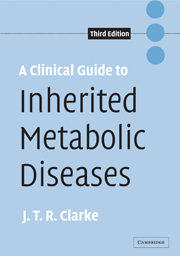Book contents
- Frontmatter
- Contents
- Reviews of first edition
- Reviews of second edition
- List of tables
- List of figures
- Preface
- 1 General principles
- 2 Neurologic syndrome
- 3 Metabolic acidosis
- 4 Hepatic syndrome
- 5 Cardiac syndromes
- 6 Storage syndrome and dysmorphism
- 7 Acute metabolic illness in the newborn
- 8 Newborn screening
- 9 Laboratory investigation
- 10 Treatment
- Index
- References
6 - Storage syndrome and dysmorphism
Published online by Cambridge University Press: 10 September 2009
- Frontmatter
- Contents
- Reviews of first edition
- Reviews of second edition
- List of tables
- List of figures
- Preface
- 1 General principles
- 2 Neurologic syndrome
- 3 Metabolic acidosis
- 4 Hepatic syndrome
- 5 Cardiac syndromes
- 6 Storage syndrome and dysmorphism
- 7 Acute metabolic illness in the newborn
- 8 Newborn screening
- 9 Laboratory investigation
- 10 Treatment
- Index
- References
Summary
Over the years, the distinction between what was conventionally regarded as dysmorphic syndromes and inborn errors of metabolism has become blurred by the recognition that the consequences of many inborn errors of metabolism include physical features, such as facial dysmorphism, that would almost certainly be regarded as developmental defects if the nature of the underlying metabolic defect were not known. In fact, the discovery of a specific metabolic defect in patients with Smith-Lemli-Opitz (SLO) syndrome, a classical dysmorphic syndrome, has led to the suggestion that perhaps all hereditary dysmorphic syndromes should be regarded similarly – as inborn errors of metabolism – in which the specific metabolic defect has not yet been identified. At the other extreme, if the physical features of Hurler disease, resulting directly from abnormal accumulation of the substrate of a defective enzyme, are regarded as ‘dysmorphic’, then perhaps any inherited metabolic disease showing physical abnormalities should be regarded as dysmorphic syndromes. The issue is raised to underscore the fact that the distinction between the two types of disorders is breaking down, and various biochemical and metabolic studies are being employed increasingly by clinical geneticists in the investigation of dysmorphism, particularly in infants presenting acutely ill early in life. The questions to be addressed in this chapter are:
Are there characteristics of the dysmorphism that should prompt metabolic investigation?
What are the types of inherited metabolic diseases in which dysmorphism might be expected to be prominent?
What sort of metabolic studies are most likely to be diagnostically productive in the investigation of dysmorphism?
- Type
- Chapter
- Information
- A Clinical Guide to Inherited Metabolic Diseases , pp. 162 - 197Publisher: Cambridge University PressPrint publication year: 2005



